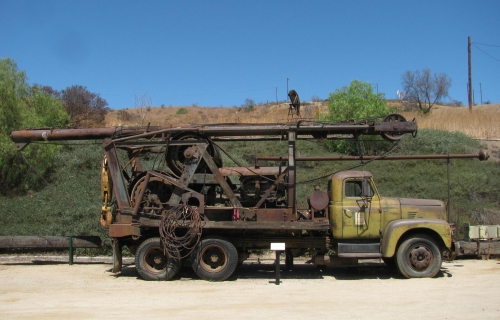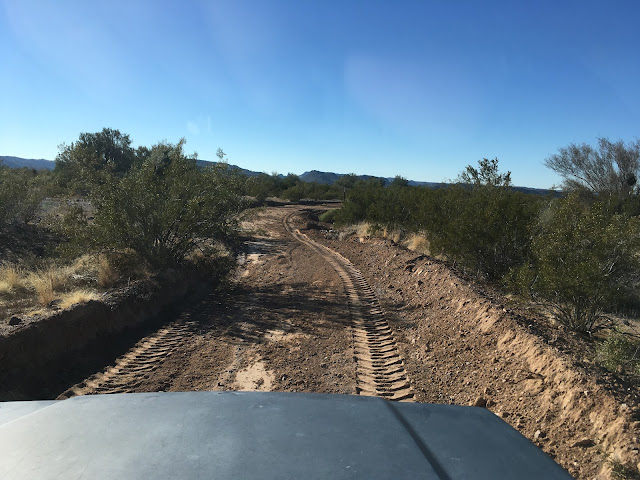Ranching in the Sonoran Desert
Odometer and trip meter: resting
This blog post is going to be fun, because I am a history buff and have been soaking up as much of Ajo’s history as I can get over the last two decades of visiting here.
Years past I have been busy chasing down aircraft wreck sites from the cadet training over the desert here, during the war years. In truth I still am, but the big backlog of crash reports has been trimmed to just a few now, so I have more free time, to pursue the rich history of this area.
.
A look down the hand dug well- note ladder to the left
Early Well Drilling Rig
The Gray Ranch at Bates Well
The ranchers were busy from 1920’s to 1950’s in this area. All the blue teardrops on the map above represent wells or earthen water holes around Ajo. The early wells are a mostly hand dug, later wells were often (but not always) drilled with a drill rig.
The well pictured above is one of the hand dug variety, and this one has a concrete liner too! (It looks like a temporary well cover has fallen into the well). This is one of three wells dug at this ranch, the first was dug in 1884. Records tell us it was 90 feet deep in 1915 with a static water level at 62 feet. An incredible feat, that was duplicated many times in this area.
This well service truck that was improvised using what looks like a 1946 Chevy truck. It was still in use in 2016 when this photo was taken at Darby well.
A couple of ranchers in this area got tired of the limitations imposed by hand dug wells and decided to invest in a powered drilling machine. The authors of the book I am reading have first hand recollections of some of the earlier “home-made” drill rigs, one of which was built mostly out of wood they had on hand. That one literally tore itself apart on contact with a rock. More robust equipment was available and two of the largest ranchers around Ajo, the Childs and the Camerons had drills from time to time and each was very accommodating when it came to drilling for other ranchers.
 |
| 1940’s J Model Fort Worth Spudder- Well Drilling Machine |
This behemoth is on display at the Castle Dome Museum near Yuma and may be indicative of the machines used in this area. Surprisingly this machine was capable of drilling 6000 feet deep.
There is nothing to suggest that it was used in the Ajo area, but it was in use in the 40’s a mere 177 miles away.
 |
| 1950s era Mobile Drill Rig |
The exact drill rig used here in the 40’s through the 50’s is unknown, but it may have looked something like the one above. Ranchers used dozers to blade a rough road into the desert hills to make a way for the drill.
If water was found, they improved the road to allow trucks to bring in materials to build a corral and loading chutes.
 |
A favorite material for corrals was used railroad ties, which were plentiful in this area. The Mine used track and rail cars to haul the ore out of the open pit mine. They also used track to get to the dump sites. As a consequence hundreds of feet of track were being laid and moved, and laid again every day. There was also a track from here to Gila Bend that needed maintenance.
Many fences were a hybrid of whatever materials could be found.
Many corrals used ocotillo cactus staves, and mesquite branches for intermediate staffs
Lastly, large troughs and tanks were necessary to get the water to the herds. A vast majority of these were poured concrete
Most wells were fitted with a wind pump and the ranch hands rode the circuit turning on the pumps to fill a large tank, which in turn filled the troughs.
Darby Well and Troughs
Now the Granddaddy of all wells in this area is the well serving the mine and town. This well is located 6 miles north of town.
 |
| New Cornelia Mine Water wells, Ajo, AZ |
When the New Cornelia Mine started up in Ajo, they bought up all the small mining claims and consolidated their efforts on digging the biggest open pit mine in the southwest. To make this work, they needed water, and lots of it. They had a renowned geologist survey out the most promising place to look for water, and dug a mine shaft down to get it. The photo above shows the twin shafts with the head rigs over each.
 |
| The 650 foot level of the Ajo Water Well |
The miners dug a shaft 750 feet deep, encountering water at 650. One hundred feet of horizontal shafting was dug at the 650 ft level and pumping equipment was installed there. This series of wells provided 197 gallons per minute to the town and the mine. Now that the mine has closed down, Ajo Improvement Co., a subsidiary of the mining company, Freeport-McMoRan, still provides quality drinking water to Ajo and the surrounding area, from these wells.
This is the point where I’d love to show pictures of the fine ranch houses and haciendas. Sadly very few of the old ranches I have visited have any standing buildings, and the book really doesn’t have a lot of discussion as to why in the 80 years since they were in daily use- they have almost completely vanished.
I have made several observations as to why the structures are disappearing.
First, most of these ranches were not fine stately buildings. The ranch hands were the labor force and the building crews. Milled timbers and sheet goods were distant and expensive.
Also the ranch houses were often built from the materials most abundant, such as sand, gravel and stone. The cement and mortars used were not always carefully measured and recipes varied greatly. Used wood railroad ties, scrawny mesquite trees and Ocotillo cactus were sometimes used for parts of the wall and roof framing and the exterior was usually stucco. Any purchased milled lumber, usually went to making the roof. And corrugated sheet metal was used in abundance.
Another reason is that when a ranch was abandoned, the materials were salvaged for other projects, or incorporated into the next house.
Lastly, the BLM, Cabeza Prieta National Wildlife Refuge, Organ Pipe National Monument, and the US Air Force all seem bent on eradicating signs of human life in the desert around here. I have been told stories of crews burning, and scraping old structures that remained on government property.
 |
| Phil and Pauline Childs’ House built around 1951 (photo 2024) |
The ranch house shown above was added to the Childs ranch when the son married and moved out of the family home. The house was built without an indoor bathroom as were many houses in the rural west. The house did have a kitchen with water piped in from the main water tank.
Henry Gray came to southern Arizona in the 1920’s and purchased the grazing rights for the area that is now occupied by Organ Pipe National Monument. Gray decided to have one of his ranch houses at Growler Wash where there was an existing well dug in 1870 by W.B. Bates. The house shown above was a surplus mine building from the nearby Growler Mine and was moved to the well in 1942 and re-purposed.
 |
| The Kitchen of the Gray’s Ranch House |
The Organ Pipe NM was created in 1937. Since the ranch was their sole livelihood, the Gray’s were put on notice that ranching on the monument would end when the last of the present family died, or moved away. Robert Jr., the last living member of the family, ranched here until he died in 1976. There had been two resolutions submitted to congress to reimburse the family for the loss of their grazing rights- but alas, neither bill was passed and the Grays basically got screwed.
 |
| Gray Family Alamo Canyon Ranch House |
The Grays are also responsible for building this outpost in Alamo Canyon. One of the best outposts we’ve seen. Good craftsmanship and nice brick. These walls have stood the test of time, put on a new roof, new windows and doors and good for another century.
At the height of WWll when the aerial gunnery and bomber training was at its highest levels, and the New Cornelia Mine was in full swing, the Childs ranch had 6000 head of cattle on the range here. The rains were more frequent, the slopes were covered with grass and forbs. Childs was slaughtering 16 cows a day, seven days a week to keep up with demand from the town and the military.
However the range could not withstand the pressure. The grasses gave way to creosote brush and brittle bush, and the water eroded the hills and plains.
Today the recommendation is that in the Sonoran desert, it takes one square mile to support one cow and one calf for a month. The days of big herds and big ranches are gone.
Thanks for tuning in.
Your Traveling Friends
Jeff and Joan















Comments
Post a Comment